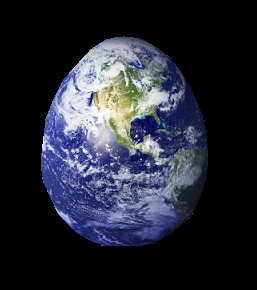 The egg is a prominent symbol of Easter and a fitting metaphor for the Earth. It contains the promise of new life and at the same it is fragile and can be easily broken. As a festival celebrating the return of spring and as a Christian holiday, Easter calls us to remember the cycles of renewal and the interconnectedness of life and death.
The egg is a prominent symbol of Easter and a fitting metaphor for the Earth. It contains the promise of new life and at the same it is fragile and can be easily broken. As a festival celebrating the return of spring and as a Christian holiday, Easter calls us to remember the cycles of renewal and the interconnectedness of life and death. Above all, Easter symbolizes new life, rebirth, and renewal. From an ecological perspective this is precisely what is required as we engage the serious work of being better environmental stewards. A number of symbols have become part of the Easter tradition. Some are directly related to the life of Jesus Christ and some have a pagan background.
For Christians, Easter is a celebration of Christ's resurrection, the ultimate symbol of rebirth. Easter's known pagan roots date back to the 8th century, specifically an Anglo-Saxon fertility goddess known as "Eostre," whose name may be derived from "eastre," meaning spring.
The Easter Egg is taken from Celtic and Teutonic pagan traditions. Eggs are directly associated with springtime festivals in many older texts and narratives. From a Christian perspective, Easter eggs are said to represent Jesus' emergence from the tomb and resurrection.
Decorating eggs for Easter is a tradition that dates back to at least the 13th century. One explanation for this custom is that eggs were formerly a forbidden food during the Lenten season, so people would paint and decorate them to mark the end of the period of penance and fasting, then eat them on Easter as a celebration.
Judaism celebrates Passover around this time of year and it commemorates the Hebrews' escape from Egyptian enslavement. This is metaphorically relevant to ecology as a symbol of freedom from the bondage of environmental destruction.
With so many around the world seeking to renew our relationship to the Earth, Easter is particularly relevant in modern times.
Easter is an opportunity to reconsider our relationship to this planet, and a good time to reflect on the truly transformational work that lies ahead. Easter is also an aspirational homage to the possibility that we can live in harmony with our environment.
© 2014, Richard Matthews. All rights reserved.
Related Articles
A Thanksgiving Infused with Environmental Gratitude
Why We Need a New Climate Change Narrative
Overcoming Obstacles in the Creation of a New Climate Narratives
Crafting a Positive Environmental Narrative
Pessimism is Impeding Environmental Advocacy
A New Environmental Movement Breeds Hope for the Future
Environmental Success Stories: Mercury, SLCPs and Many More
Forging a New Climate Change Narrative: Addressing 5 Psychological Realities
Video - It's all in our heads: The psychology of sustainability
Video - Making People Care About Climate Change: The Psychology of Risk Perception
Video - Al Gore on Climate Change: "We are Going to Win We are Going to Fix This"
Video - Changing the Narrative to Change the World
Video - Narratives on Carbon Pollution: Are Individuals to Blame for Carbon Pollution?
Guide - Solutions to Sustainable Living: A New Narrative
The Power of Story Telling for Sustainable Businesses
The Power of Storytelling: Lessons in Consumer Engagement
Video - Indigenous Vs. Western: Environmental Stewardship and Sustainability
Indigenous Ecology in Environmental Education
Making Environmentalism Everyone's Concern
Building Support for Action on Climate Change Before We Reach Tipping Points
Why We Need to Reach American Climate Change Deniers
How to Get Through to Climate Deniers
Is There More to the Mayan Prophecy than Meets the Eye?
0 comments:
Post a Comment